..::Temple of Artemis at Ephesus::..
It’s only a temple, so how can it be a Ancient Wonder? What’s so special about this temple that makes it an Ancient Wonder? Its beauty and the will power of the citizens to build it and re-build it, thats what makes it so special...
Location
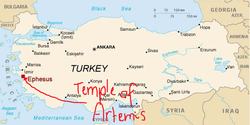
The ancient city of Ephesus, close to the modern town of Selcuk, Turkey.
Infomation
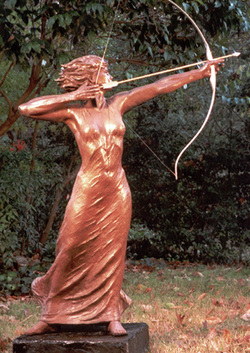
The Temple of Artemis (or the Temple of Diana) was a Greek temple dedicated to the Greek Goddess Artemis. It was completed in its most famous phase. Even though the Temple is the 3rd Wonder of the Ancient world the only thing that remains are foundations and a few columns. There where previous Temples on this site, but where destroyed. The Temple was made from marble everywhere apart from the roof.
History
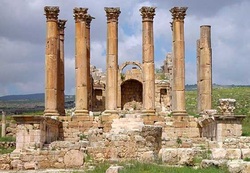
The foundation of the temple dates back to the 7th Century BC, the actual structure that placed itself in the Ancient Wonder list dates back to around 550 BC. The other names that the temple had where Great Marble Temple or Temple D. It’s was sponsored by the Lydian King, Croesus, and was designed by a Greek architect named, Chersiphron. It was beautifully decorated with bronze statue’s by the best artists of the time.
The temple was made to honour the Greek Goddess of hunting and wild nature.
The temple was used for two reasons, a marketplace and a religious society. For years the Temple was visited by merchants, tourists, crafters and Kings who payed homage to the Goddess by giving her some of their profits. Recent items were found at the site, some of these items where, statues of Airtimes made from gold and ivory, earrings, bracelets and necklaces.
On the 21st of July 356 BC, a man who’s name was Herostratus decided to burn the Temple to the ground just to make his name known forever. And he succeeded. And strangely, Alexander the Great was born on the same on the same night. A Romans historian, Plutarch wrote that the Goddess was “too busy taking care of Alexandra to send help to her threatened temple.” Over the next 20 years, the temple was re-built and was labelled “Temple E” by archaeologists. And when Alexandra the Great bet Asia Minor, he helped re-build the destroyed temple too!
When St. Paul visited Ephesus to preach for Christianity in 1st Century AD, he was confronted by the Artemis Group who had no plans ditching their Goddess and going over to the Christian God. And then the temple was destroyed again by the Goths in AD 262, the Ephesians promised to re-build it. By 4th Century AD, most Ephesians had changed to be Christian and the temple lost its religious glamour. In AD 401 the Temple of Artemis was torn down by St John Chrysostom. Ephesus was later abandoned, and in the 19th century the site had been dug out and cleared.
Attempts have recently been made to try and re-build the Temple, but only a few columns have been re-erected.
The temple was made to honour the Greek Goddess of hunting and wild nature.
The temple was used for two reasons, a marketplace and a religious society. For years the Temple was visited by merchants, tourists, crafters and Kings who payed homage to the Goddess by giving her some of their profits. Recent items were found at the site, some of these items where, statues of Airtimes made from gold and ivory, earrings, bracelets and necklaces.
On the 21st of July 356 BC, a man who’s name was Herostratus decided to burn the Temple to the ground just to make his name known forever. And he succeeded. And strangely, Alexander the Great was born on the same on the same night. A Romans historian, Plutarch wrote that the Goddess was “too busy taking care of Alexandra to send help to her threatened temple.” Over the next 20 years, the temple was re-built and was labelled “Temple E” by archaeologists. And when Alexandra the Great bet Asia Minor, he helped re-build the destroyed temple too!
When St. Paul visited Ephesus to preach for Christianity in 1st Century AD, he was confronted by the Artemis Group who had no plans ditching their Goddess and going over to the Christian God. And then the temple was destroyed again by the Goths in AD 262, the Ephesians promised to re-build it. By 4th Century AD, most Ephesians had changed to be Christian and the temple lost its religious glamour. In AD 401 the Temple of Artemis was torn down by St John Chrysostom. Ephesus was later abandoned, and in the 19th century the site had been dug out and cleared.
Attempts have recently been made to try and re-build the Temple, but only a few columns have been re-erected.
How's the Temple a Wonder?
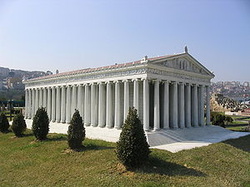
The Temple of Artemis won its place in the Ancient Wonder’s list my its beauty and size. It was a very impressive building, with all the pieces of artwork and the structure of the place. It was one of the biggest buildings that the Greeks built, as well as the only one to be built from marble.
Description
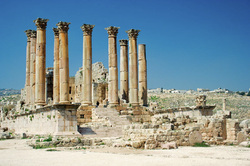
The foundation of the temple was rectangular, similar to most Temples of that time. Unlike other buildings, the Temple was made of marble, with a decorated façade that overlooked a massive courtyard. Marble steps surrounded the building, the columns were 20 m high with Ionic capitals and carved circular sides. There were 127 columns all together, they were lined orthogonally over the whole platform area, except for the entrance to the House of Goddess.
The Temple has heaps of art works, including ancient bronze statues of Amazons that were made by the hand of the most famous sculptors of the time. When St Pauls came to the Temple, it was decorated with golden pillars and silver statues, and it was decorated with beautiful paintings. There is no proof that there was a statue of the Goddess in the centre of the building, but there is no reason for her not to be.
The early very detailed descriptions of the temple helped archaeologists re-build the building. More correct reconstructions might give us an idea about the layout of the Temple.
The Temple has heaps of art works, including ancient bronze statues of Amazons that were made by the hand of the most famous sculptors of the time. When St Pauls came to the Temple, it was decorated with golden pillars and silver statues, and it was decorated with beautiful paintings. There is no proof that there was a statue of the Goddess in the centre of the building, but there is no reason for her not to be.
The early very detailed descriptions of the temple helped archaeologists re-build the building. More correct reconstructions might give us an idea about the layout of the Temple.
